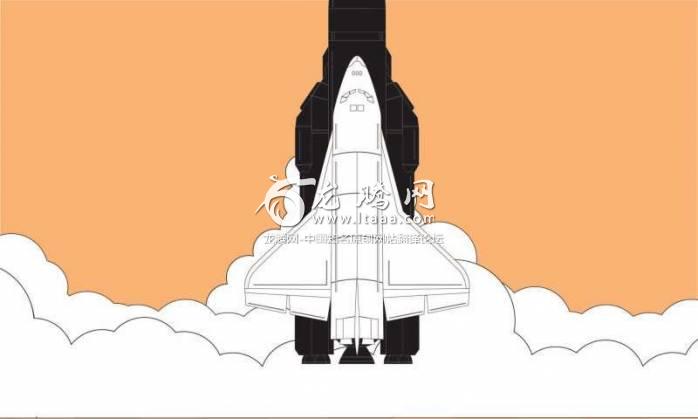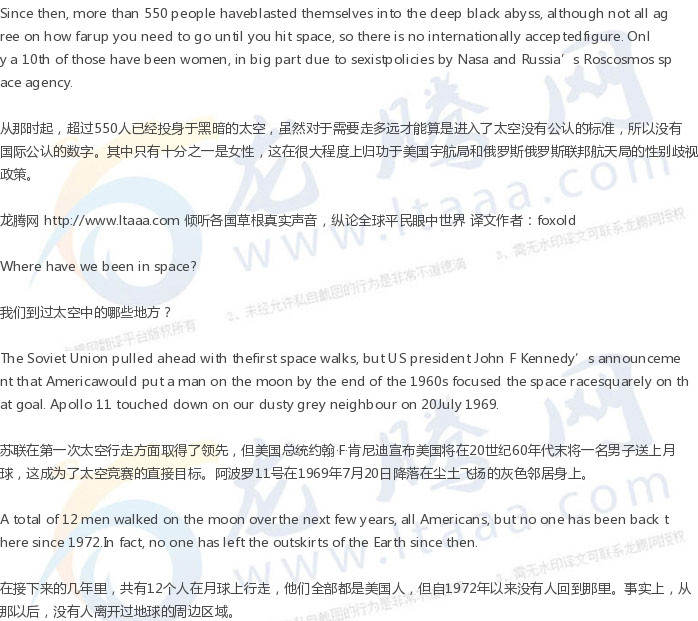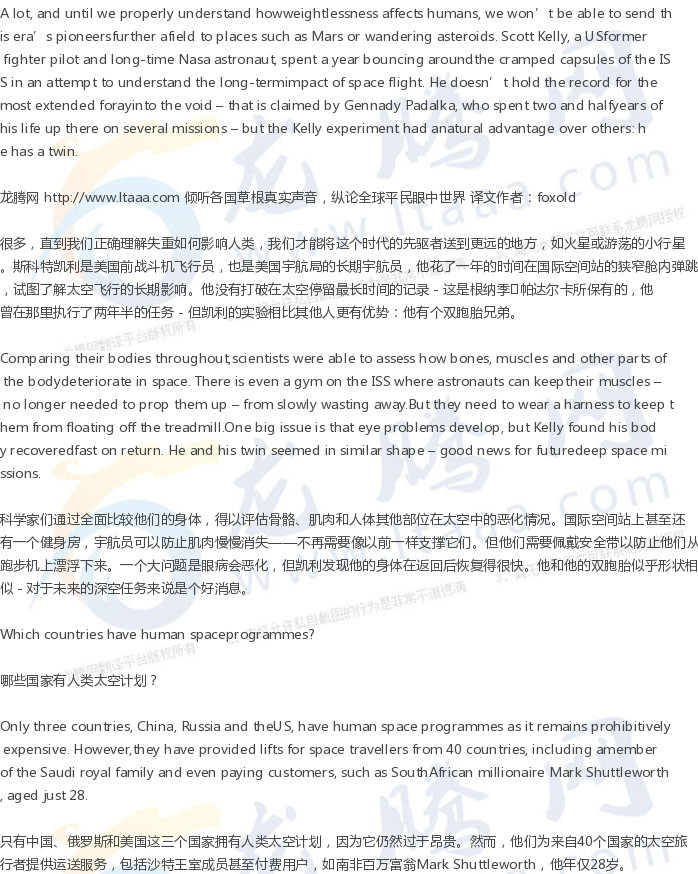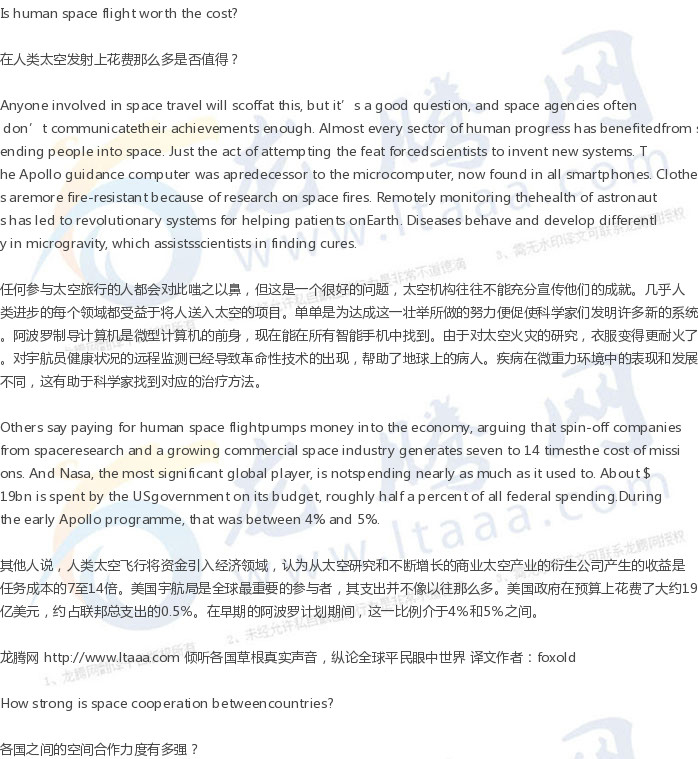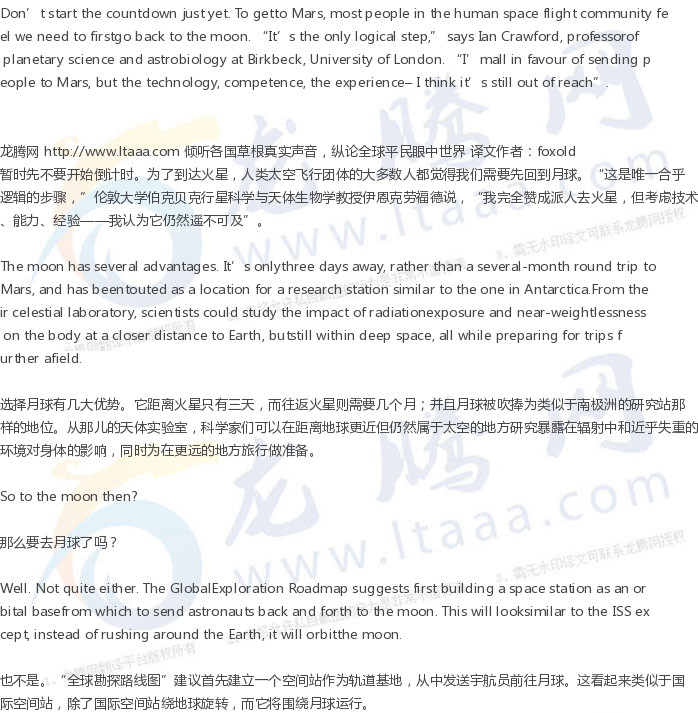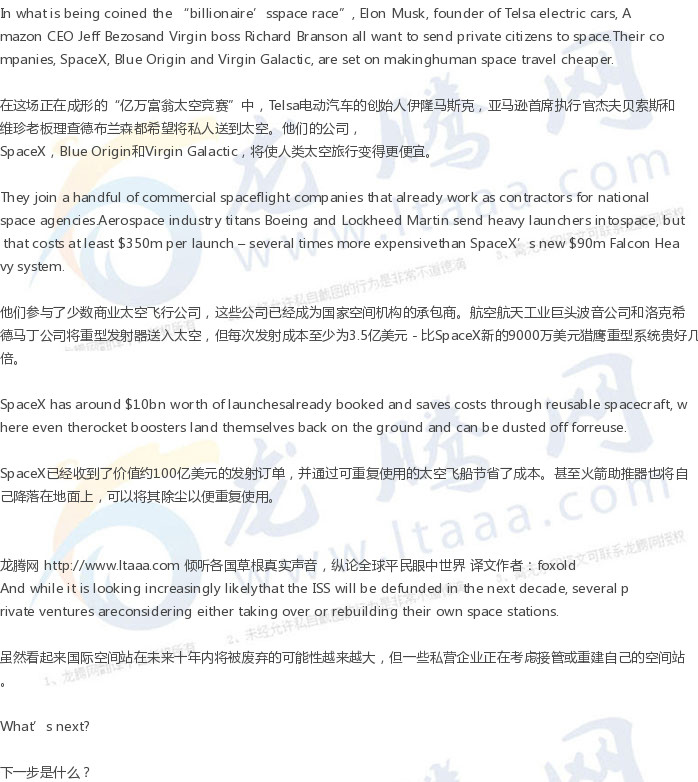太空:我们已经走了多远 - 我们要去哪里? [英国媒体]
亿万富翁企业家正试图创造适合人类旅行的火箭,而政府机构则花费数十亿美元进一步拓展他们的探险。但是,我们离那个红色的星球还有很长的路要走
Space: how far have we gone – and where arewe going?
太空:我们已经走了多远 - 我们要去哪里?
Billionaire entrepreneurs are trying tocreate rockets fit for human travel, while government agencies spend billionsfurthering their explorations. But we are still a long way off from making ourway to the red planet
亿万富翁企业家正试图创造适合人类旅行的火箭,而政府机构则花费数十亿美元进一步拓展他们的探险。但是,我们离那个红色的星球还有很长的路要走
Who has travelled to space?
谁去过太空?
Space flight is now a venerable industry.Humanity’s first space explorer, Soviet cosmonaut Yuri Gagarin, orbited aroundthe globe on 12 April 1961, more than half a century ago, when Britain remaineda colonial power and people were still using halfpennies to buy their fish andchips.
太空飞行现在是一个值得尊敬的行业。人类的第一个太空探险家,苏联宇航员尤里·加加林于1961年4月12日在围绕地球飞行,半个多世纪以前,那时英国仍然是殖民大国,人们仍在使用半便士购买鱼和薯条。
We imagine astronauts floating in freespace or bouncing in moon craters, yet the majority of those lucky enough haveinstead spun around in low Earth’s orbit – between 99 and a few hundred mileshigh. That’s where the vast array of communications and navigation satelliteslive, speeding at thousands of miles an hour to avoid plummeting back to earth.
我们想象宇航员在自由空间漂浮或在月球陨石坑中弹跳,但大多数幸运的人却只是在低地球轨道上旋转 - 在99到几百英里之间。这就是大量通信和导航卫星所在的地方,它们以每小时数千英里的速度飞行,以避免坠落到地球上。
What do we do there?
我们在那做什么?
Even though we did not go back to deepspace, humans have begun to live and work outside the Earth’s atmosphere, oftenconducting experiments on themselves to determine the effects ofweightlessness, or microgravity, on the human body.
即使我们没有回到深空,人类也开始在地球大气层外生活和工作,经常对自己进行实验,以确定失重或微重力对人体的影响。
By 1986, the Soviet Union had launched theMir space station. When it eventually fell to Earth (thankfully unoccupied) andburned up, our current space outpost, the International Space Station (ISS),was launched. Since 2000, humans have been living in space constantly. Thereare three up there at the moment, speeding around the globe once every 90minutes.
到1986年,苏联发射了和平号空间站。当它最终落到地球(幸亏无人居住)并被烧毁时,我们目前的太空前哨 - 国际空间站(ISS)也已启动。自2000年以来,人类一直生活在太空中。目前有三个人在空间站上,每90分钟环绕地球飞驰一圈。
What happens to the body in space?
在太空中的身体会发生什么变化?
How much does it cost to send them up?
发送它们进入太空需要花多少钱?
Astronomical. The ISS is the most expensivemachine ever constructed with a price tag at around $150bn (£115bn). Nasa’sspace shuttle programme, which kicked off in the early 1970s by promising safeand affordable access to space, hoped to cost just a few tens of milliondollars per launch. But as the shuttle was thrown in the scrapyard in 2011, theagency estimated the total cost at $209bn — nearly $1.6bn per flight.
天文数字。国际空间站是有史以来最昂贵的机器,价格约为1500亿美元(合1150亿英镑)。美国宇航局的航天飞机项目于20世纪70年代初开始实施,预计能够安全且以合理的价格进入太空,希望每次发射只花费数百万美元。但随着航天飞机于2011年被废弃,该机构估计总成本为2090亿美元 - 每次发射耗费近16亿美元。
Following the big fight over the shuttle,which looked fantastic but also restricted space adventuring to Earth’s orbitas well as costing a fortune, the US took a side seat in launches. Mostastronauts are now sent by the Russian space agency, which sells round-triprides on its Soyuz spacecraft for between $21m and $82m.
航天飞机看起来很棒,但对冒险进入地球轨道有很大的限制,且耗费大量财富。在对航天飞机做出一番努力之后,美国在太空发射领域让出了第一的宝座,大多数宇航员现在都是由俄罗斯航天局发送的,该机构以其2100万美元至8200万美元的价格出售其联盟号宇宙飞船的往返运送服务。
The first space race was part of thechest-beating of the cold war, but since then human space exploration has beenmore about countries working together than against each other. The ISS is amassive collaboration between five space agencies (Nasa, Roscosmos, Japan’sJaxa, the pan-European agency ESA and the Canadian Space Agency) and wasassembled over a period of 13 years from 1998, slowly adding capsules likeLego.
第一次太空竞赛是冷战交锋的一部分,但从那以后,人类太空探索更多地是关于国家之间一起合作而不是相互对抗。国际空间站是五个空间机构(美国国家航空航天局,俄罗斯联邦航天局,日本的Jaxa,泛欧机构ESA和加拿大航天局)之间的大规模合作,从1998年开始组装了13年,像乐高积木一样慢慢增加太空舱数量。
A big exception to this is China, which hasgone it alone with its space ambitions, never sending an astronaut to the ISS.In 2006, Beijing reportedly tested lasers against US imaging satellites in whatappeared to be an attempt to blind or damage them, and US lawmakers laterbanned cooperation between Nasa and China’s state agency.
一个很大的例外是中国,凭借其在太空领域的雄心,它独自开展航天项目,从未派遣宇航员进入国际空间站。据报道,2006年北京对美国的成像卫星进行了激光测试,似乎试图使其失明或受损,美国立法者后来禁止美国宇航局与中国国家机构之间的合作。
However, the future of any effective humanspace flight is certainly likely to be cooperative rather than antagonistic.Since 2011, national spaces agencies in 14 countries have attempted tocoordinate their dreams into a single vision. The most recent plan, publishedin January this year, said they had agreed to “expand human presence into thesolar system, with the surface of Mars as a common driving goal”.
然而,任何有效的人类太空飞行项目未来肯定是倾向于互相合作而非对抗。自2011年以来,14个国家的国家空间机构试图将他们的梦想协调为一个单一的愿景。今年1月发布的最新计划称,他们已经同意“将人类的存在扩展到太阳系,火星表面将成为大家共同的目标”。
We’re off to the red planet? Hurray!
我们出发前往那个红色星球?欢呼!
Will we ever get to Mars?
我们能到达火星吗?
It is a mammoth feat and it would be wiseto expect serious delays. “Where we go in space is decided by a combination ofwhat people would like to do and the reality of time and budgets,” says HenryHertzfeld, director of the Space Policy Institute at George WashingtonUniversity, Washington DC, and a former policy analyst at Nasa. “The idea of puttingpeople on Mars has been around for a long time. If you read the policies, it isclearly a long-term vision without a date. But we probably are still lackingthe technology to keep people for a long time in deep space.”
这是一个伟大的壮举,计划可能会有非常严重的延误。华盛顿乔治华盛顿大学空间政策研究所所长,前美国宇航局政策分析师亨利赫兹菲尔德说:“我们在太空中能到达的位置取决于人们想做什么以及实际的时间和预算。把人送到火星上的想法已经存在了很长时间。如果您阅读这些政策,那么这显然是一个没有确定日期的长期愿景。但我们可能仍然缺乏使人们可以长期留在深空的技术。
Who are the new contenders in human spaceflight?
谁是人类太空飞行的新竞争者?
The US and Russia have been giving way tonew players. In 2003, China became the third country to put a person into orbitand India plans to follow in 2022. But the sector-changing impact isundoubtedly coming from the private space.
美国和俄罗斯一直在让位给新成员。2003年,中国成为第三个将人送入轨道的国家,印度计划在2022年跟进。但是,足以对行业造成改变的影响无疑来自私人领域。
As government agencies prioritise the moon,others are looking straight at Mars. Musk has said his life goal is to create athriving Mars colony as a fail-safe for humanity in case of a catastrophicevent on Earth, such as a nuclear war or Terminator-style artificialintelligence coup. For this, SpaceX is developing the Big Falcon Rocket (BFR),which he claims could send crewed flights to the red planet by mid-2020.
在政府机构优先考虑月球的同时,其他人的双眼正在盯着火星。马斯克曾表示,他的人生目标是创造一个繁荣的火星殖民地作为人类的安全保障,以防在地球上发生灾难性事件,如核战争或终结者式的人工智能政变。为此,SpaceX正在开发大型猎鹰火箭(BFR),他声称这种火箭有能力在2020年中期之前向红色星球发送载人航班。
Musk says the BFR is partly inspired byTintin’s rocket and will be the biggest ever made at close to 40 storeys highand capable of ferrying as many as 100 passengers per trip, depending on howmuch luggage they want to put in the hold.
马斯克表示,BFR的部分灵感来自Tintin的火箭,并将成为有史以来最大的,约有40层楼高,并且每次旅行能够运送多达100名乘客,具体取决于他们想要放入多少行李。
As well as a healthy satellite launchbusiness, SpaceX is raising money by selling tickets on the BFR for a trip,some would say a jolly, around the moon. Yusaku Maezawa, a Japanese fashionbillionaire and art collector, is funding such a mission slated for 2023 andsays he is going to invite artists with him for the week-long trip to re-engagethe public in the wonder of our universe.
除了健康的卫星发射业务外,SpaceX还通过出售搭乘BFR环游月球的旅行票来筹集资金,有些人会认为那种旅行非常有意思。日本时尚亿万富翁和艺术收藏家Yusaku Maezawa正在为2023年的这项任务提供资金,并表示他将邀请艺术家与他一起进行为期一周的旅行,让公众重新关注我们宇宙的奇迹。
版权声明
我们致力于传递世界各地老百姓最真实、最直接、最详尽的对中国的看法
【版权与免责声明】如发现内容存在版权问题,烦请提供相关信息发邮件,
我们将及时沟通与处理。本站内容除非来源注明五毛网,否则均为网友转载,涉及言论、版权与本站无关。
本文仅代表作者观点,不代表本站立场。
本文来自网络,如有侵权及时联系本网站。
图文文章RECOMMEND
热门文章HOT NEWS
-
1
最近,新冠肺炎疫情在日本有扩大的趋势,有专家呼吁日本应当举国行动起来,共...
- 2
- 3
- 4
- 5
- 6
- 7
- 8
- 9
- 10
推荐文章HOT NEWS
-
1
最近,新冠肺炎疫情在日本有扩大的趋势,有专家呼吁日本应当举国行动起来,共...
- 2
- 3
- 4
- 5
- 6
- 7
- 8
- 9
- 10
